What does an intrepid slow traveling couple do when they’ve settled down for a month long stay in a rural Portuguese village and they start getting itchy feet? They take a vacation from the trip, a meta-vacation if you will. Don’t try to google it, you will only get directed to sites devoted to vacationing in Meta, Italy a coastal town southeast of Naples.
At first it seemed like a strange idea, taking a vacation from our vacation. Part of me is thinking “we’re spending good money to rent this house, it doesn’t make sense to leave here and spend even more money to stay somewhere else.” Once I wrapped my head around the concept that this house we’re renting is our “home”, even if it is for only a month, getting away for a couple of days now is no different than what we would occasionally do in our previous life. This became the most recent example of how our life has changed.
About two weeks into the Portuguese leg of our trip, both Fara and I started to feel a little restless. Up to this point, we had only explored the area immediately surrounding Mortágua and we agreed that it was time to go a little further afield. Fara had plastered the wall next to our kitchen table with a series of post-it notes listing various destinations within a few hours drive and why we would want to go there. Through helpful suggestions from local friends and Fara’s research, we settled on a plan to visit the hillside town of Sintra.
Sintra town
Sintra is a small hillside town about 30 km from Lisbon. Due in part to its proximity to the Portuguese capital and designation as a UNESCO World Heritage site, it is a popular day trip for many tourists. We like staying places that a typical tourist will only experience for a few hours. You then get two experiences for the price of one. What is a crowded and busy tourist area during the day will likely transform into a sleepy town square after the throngs of people return to their home base. Our hostel was located on a narrow, steep and “dangerous” one way street just down the hill from the main historic center. Several sources warned to not drive a car in Sintra due to the maze of one way streets and overall lack of parking, but recent TripAdvisor reviews of the hostel gave the impression that this wouldn’t be a problem. We weren’t disappointed, despite the heavy traffic and clueless tourists forgetting red means don’t cross the street, we made it to our destination and found street parking a short (although very vertical) hike from the hostel. After checking in and learning that after 5 or 6 pm the street parking will open up right in front of the hostel (yay! day trippers), we were ready to grab some lunch and check out the sights.
National Palace of Sintra (Palácio Nacional de Sintra)

The National Palace is in the center of old town and dominates the landscape with its twin conical chimneys (affectionately referred to by some as Madonna’s bra). This moniker is steeped in a bit of irony since the Material Girl recently purchased an 18th century palace in Sintra. Fara was getting over a stomach bug and didn’t feel like touring the palace, so I dropped her off at a nearby cafe and went it alone.
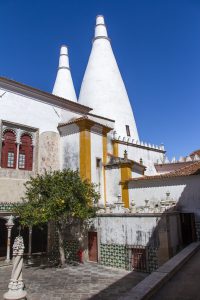
The palace itself is very well preserved, especially when considering the palace was initially built in the 14th century and had been used continuously until the late 19th century. However, I have to be honest, it is a little on the boring side. The architecture was pretty plain and many of the rooms were nearly empty, save the occasional ornately carved bureau or four-poster bed. The only “Wow!” moment happened upon entering the kitchen, where the reason for the giant cone chimneys became clear. Each hollow cone covered half the kitchen where the smoke from the wood cooking fires would supposedly escape without asphyxiating the kitchen staff. Pictures could not do it justice (at least none of the pictures I took).
Pena Palace (Palácio da Pena)
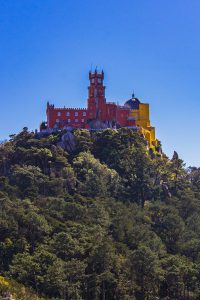
High above the town of Sintra sits the most visited of the Portuguese palaces. Pena Palace was built by King Ferdinand II in the mid 19th century on the ruins of an old monastery and is a striking example of the architectural opulence common of the period. As you walk up to it from the main road, the first real view you get of the palace is an eclectic mix of many different “Neo-” architectural styles (Moorish, Gothic, Renaissance, etc). While bordering on gaudy and garish, I’d consider the exterior of the palace to be very beautiful and interesting. Fara put it best when she said it felt a little like a Las Vegas casino. Not because there were slot machines everywhere, but that the palace had the flavor of many different places.
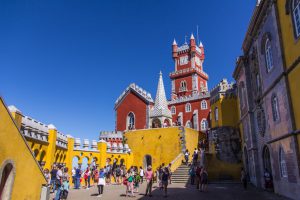
Castle of the Moors (Castelo dos Mouros)
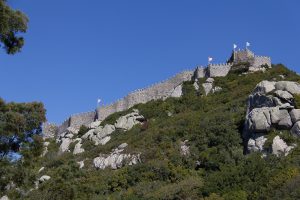
Perched high on a ridge near Pena Palace lies the imposing Castle of the Moors. These two neighbors are polar opposites in almost every way possible. One is relatively new and colorful and lavish; the other is more than a thousand years older, militarily functional and looks how a medieval castle should look. The castle was built by the Moors (hence the name) when they occupied the Iberian peninsula in the 8th and 9th centuries.
Taking the trail from the main road to the castle gate follows a a long, snaking route up the side of the mountain. Along the way, it passes several archaeological sites with exhibits describing settlements, granaries and grave sites of the early settlers. Once inside the main gates, the castle initially seems a little underwhelming. There is an old cistern to explore, a few courtyards and a snack bar, but little else. Then you find a staircase leading to the top of the castle walls…
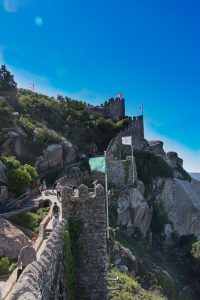
…and this is why you visit the Castle of the Moors. Yes, you get to walk the entire length of the walls. Yes, you get to climb the towers. Yes, the views of both Pena Palace and Sintra town are breathtaking. Just be sure to take care, medieval castles didn’t have safety rails.
Quinta da Regaleira
Back in Sintra town, we visited a private (instead of royal) palace also known as “The Palace of Monteiro the Millionaire.” There is a palace, but few tourists are there to see the residence. The main attraction is the 10 acres of lakes, gardens and grottoes. In the late 1800s Carvalho Monteiro purchased the estate and proceeded to renovate the grounds with symbols to reflect his interests, which included alchemy, Freemasonry, Rosicrucianism, and the Knights Templar.
One will find sculptures, fountains, towers, lakes and a chapel all connected by a network of trails in a dense forest. However, don’t forget to bring a flashlight with you. There are also two “initiation wells” which are essentially inverted towers dug deep into the hillside. Both are lined with spiral staircases and observation points along the sides; they were used for some kind of ritualistic initiation. The fun doesn’t stop there. Connecting the wells and other points on the grounds are a series of tunnels, allowing visitors to move around the grounds subterraneously (I may have just made that word up). This was by far Fara’s favorite find of the trip.
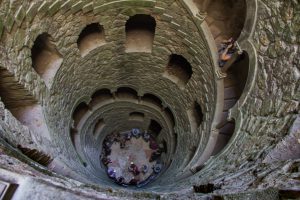
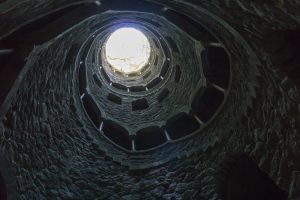
Óbidos
Full disclosure, Óbidos is not a castle in Sintra, it is a medieval walled city about an hour north of Sintra. I’m including it here because we stopped there for lunch on our way back to Mortágua. Fara’s Portugal research notes stated that Óbidos had a “way cool castle”, so how could we not visit?
We arrived in Óbidos at roughly the same time as a tourist bus. Rather than try to navigate our way through the crowd, Fara suggested we divert our path up a large stone staircase as soon as we entered the city gates. Much to our delight, we quickly found ourselves on top of the city walls!
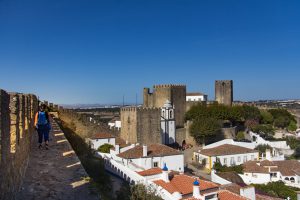
Much like the Castle of the Moors, you can walk around the perimeter of the city on the ramparts, exploring various towers and enjoying the views along the way. Again, there are no safety rails anywhere. The battlements will keep you from tumbling over the side of the wall and down the hill, but the interior is wide open and the 4 foot wide path can feel quite narrow when there’s a 40 foot drop to the city streets below. I’m pleased to say we navigated the wall without incident and made it safely back to ground level at the other end of the city. I couldn’t imagine having to do the same thing in full battle armor while under attack.
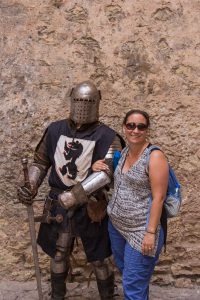
Hope you enjoyed our little meta-vacation. I realized that my previous posts were focusing only on the negative (lessons we’ve learned the hard way, packing woes or unfortunate incidents). I don’t want you, our readers, to think we’re not having any fun.


To funny, you guys saw the same places we did around Sintra, the private house with grotto gardens and Obidos. We saw one other couple in Obidos and Mike noticed the guy holding Rick Steves book, as he was. He asks them were they’re from? The guy answers, Portland. Haha, four people in the town square and we are all from Oregon. Keep sharing your travels. It’s bringing back memories for me while you two make yours.